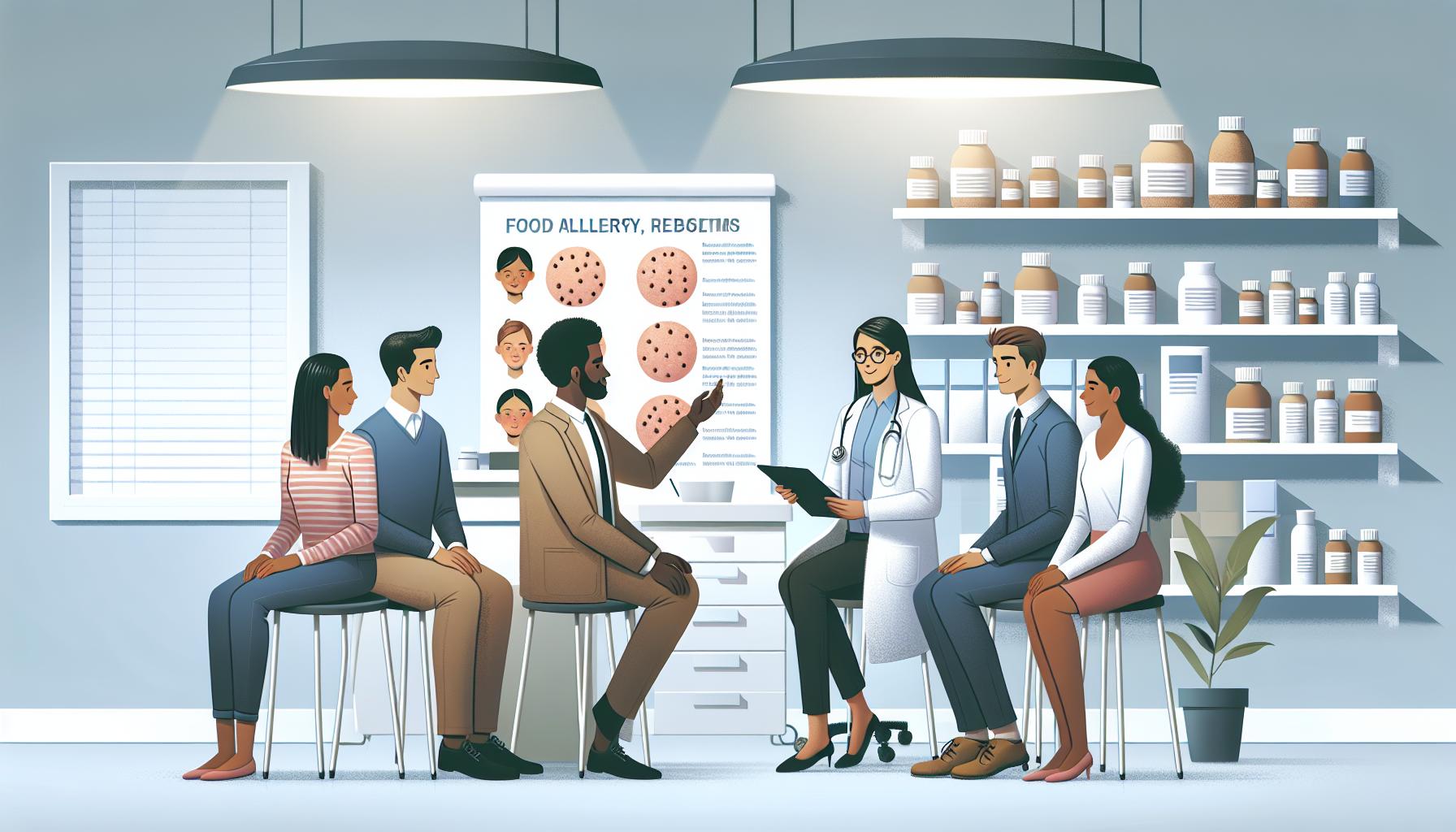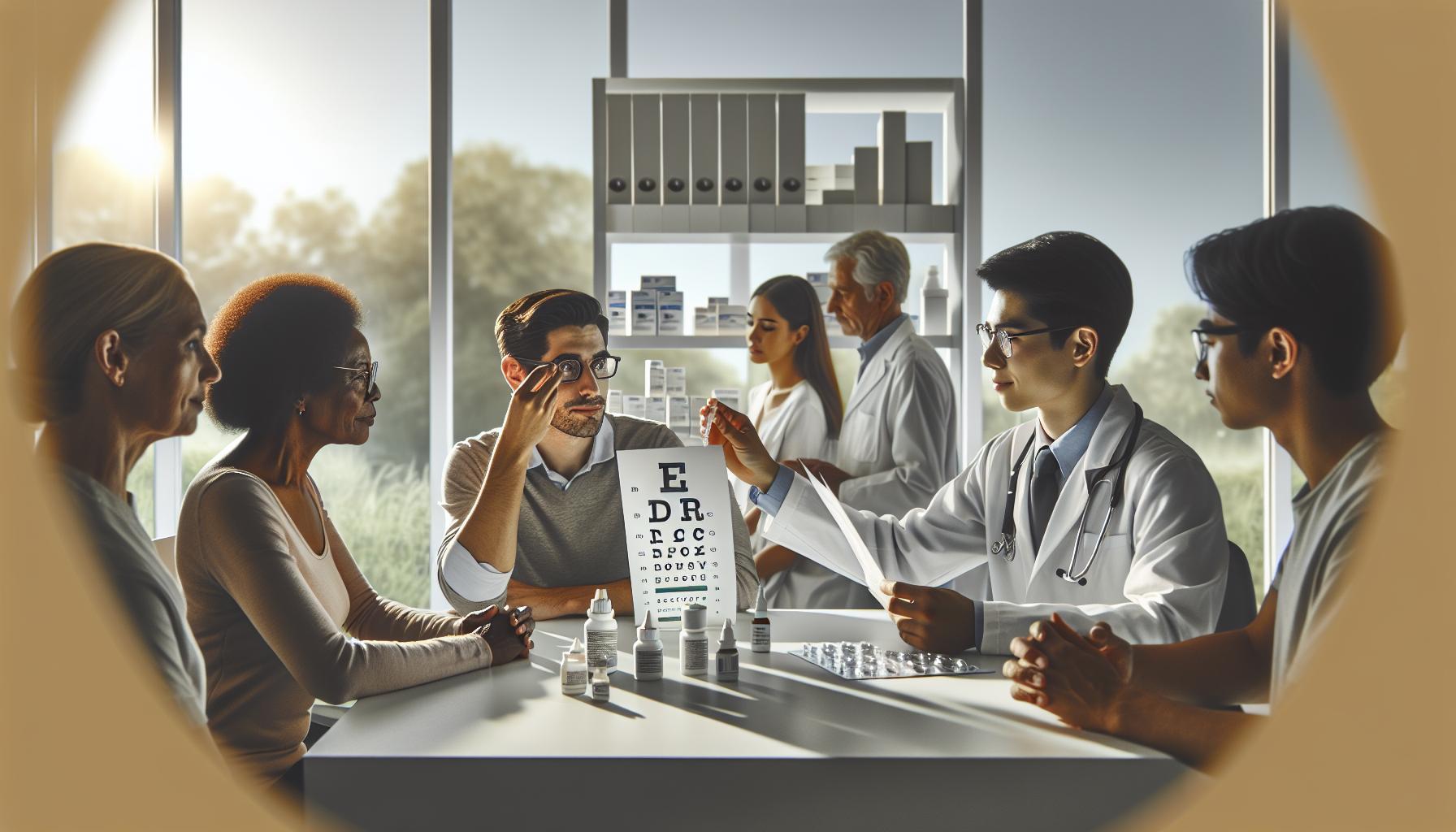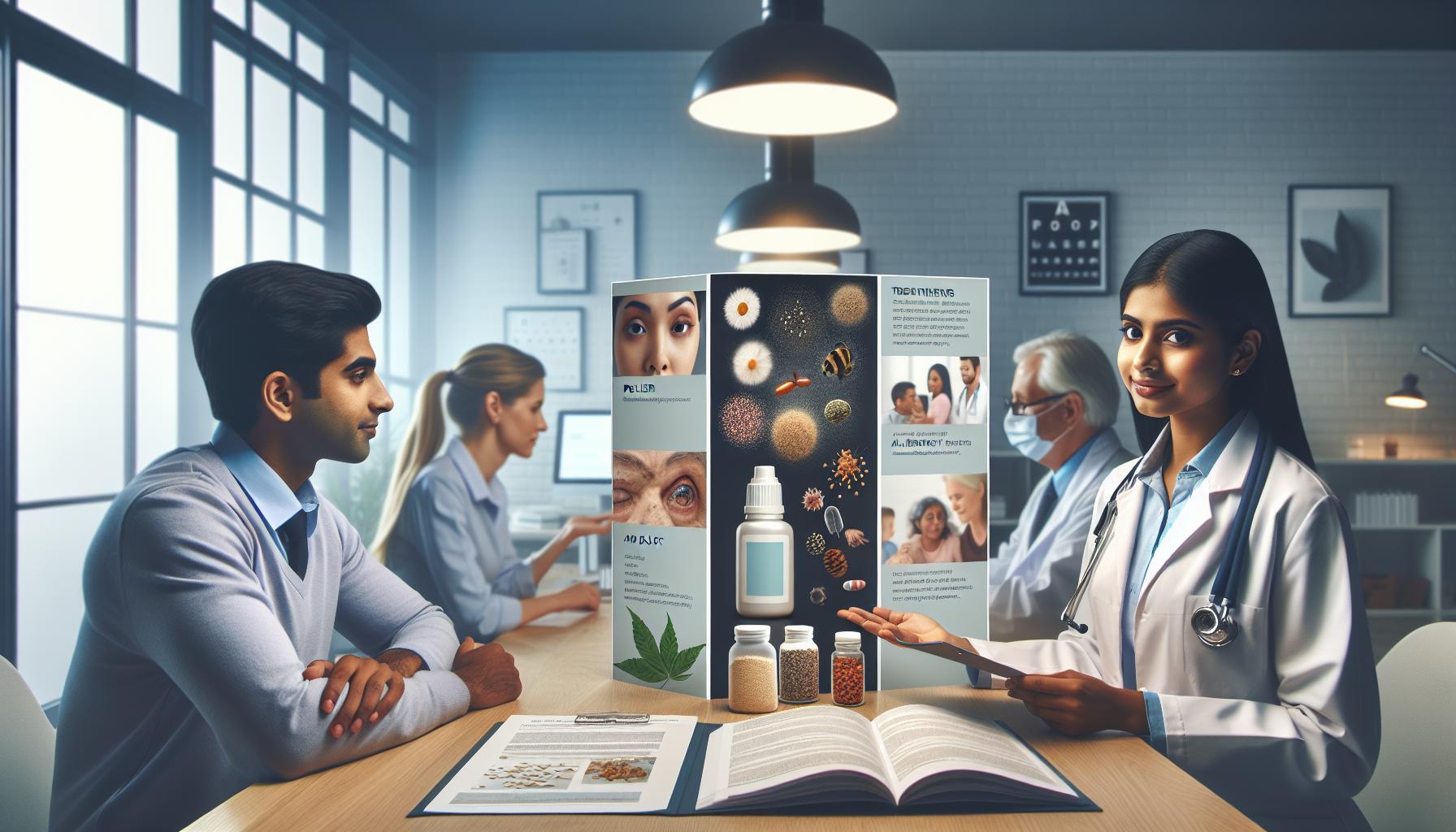Did you know that food allergies can manifest in unexpected ways, including acne? Many individuals struggle with skin issues that don’t improve despite their best skincare efforts, often overlooking potential food triggers. Understanding what food allergy acne looks like and recognizing its warning signs is crucial for those seeking clearer skin and overall well-being.
If you’ve noticed sudden breakouts or unusual skin reactions after eating certain foods, you’re not alone. This article will guide you through the characteristics of food allergy acne, helping you identify its unique features and differentiate it from other skin conditions. By becoming familiar with these signs, you can take meaningful steps toward identifying allergens and improving your skin health. Continue reading to empower yourself with knowledge that could transform your approach to skincare and nutrition.
Identifying Food Allergy Acne: Key Symptoms

Identifying food allergy acne can be daunting, especially since it often mimics other forms of acne while carrying specific triggers based on dietary choices. For many, the journey to understanding what food allergies look like on the skin begins with recognizing the signs that set food allergy acne apart from common breakouts. Food allergy acne typically appears as red, inflamed pimples, often accompanied by itchiness or a burning sensation. This distinct discomfort can serve as a critical clue in identifying its allergic nature.
Key indicators to watch for include:
- Timing of Breakouts: If acne appears soon after consuming certain foods, this may signal an allergy.
- Location on the Skin: Food allergy triggers often affect specific areas, such as the cheeks or jawline, or can cause swelling in conjunction with pimples.
- Accompanying Symptoms: Look for other allergy symptoms, like hives, nasal congestion, or gastrointestinal issues, which may suggest a broader allergic reaction.
Understanding the timeline of breakouts is essential. Generally, food allergy acne can manifest within hours to a couple of days after ingestion, differing from typical hormonal acne that often correlates with menstrual cycles. Keeping a food diary detailing what you eat and when breakouts occur can be incredibly helpful.
For those unsure whether their acne can be attributed to food allergies, consider how the skin feels and reacts after meals. Noticing patterns can empower individuals to make dietary changes and seek appropriate treatments. Remember, each person’s skin is unique; what works for one may not work for another. Validation of these experiences, coupled with effective management strategies, can lead to discovering paths toward clearer skin and improved overall well-being.
How Food Allergies Trigger Acne: The Science Explained

In the labyrinth of skin conditions, food allergies can manifest dramatically, leading to surprising skin reactions that many people might not initially connect with their diet. When the body encounters a food allergen, it triggers an immune response, which can result in inflammation, redness, and, ultimately, acne. The skin becomes a canvas for the underlying systemic reaction, presenting as inflamed, painful bumps that often create confusion and frustration for those affected.
The core mechanism behind food allergy acne lies in the body’s immune response. When you consume a food to which you are allergic, your immune system mistakenly identifies it as a threat. This prompts the release of histamines and other chemicals intended to protect the body. In doing so, these chemicals not only act on the internal systems but also cause inflammation on the skin’s surface, where the effects can be visually striking. As a result, these acne breakouts can appear suddenly and may coincide with other allergy symptoms such as rashes, itchiness, or even more severe reactions like gastrointestinal distress.
Understanding this science is critical for individuals prone to food allergies. It can help them discern potential triggers more effectively. Keeping a detailed food journal can be particularly beneficial; documenting the foods consumed alongside any subsequent skin reactions allows for clearer identification of patterns. For example, if a breakout occurs consistently after the consumption of dairy or nuts, this may indicate a specific food allergy. Recognizing such connections empowers individuals to take manageable first steps-such as eliminating certain foods and monitoring skin changes-to find relief and clarity in their health journey.
Moreover, these allergic reactions are not merely skin-deep; they reflect imbalances that can be symptomatic of broader health concerns. For many, addressing food sensitivities is not just about improving skin health but about enhancing overall wellness. By understanding the relationship between diet and skin condition, individuals can be proactive in their approach to food and skincare, paving the way for healthier choices that contribute to both their skin’s appearance and their general health.
Common Food Allergens Linked to Acne Breakouts

Certain foods are not just delightful on the palate; they can also be the unsuspecting culprits behind frustrating skin eruptions. For many individuals, identifying the is the key to reclaiming their skin’s clarity and overall health. Understanding these triggers empowers individuals to navigate the complexities of their diets, bringing them one step closer to clearer skin.
Common allergens frequently associated with acne include dairy, gluten, and certain nuts. Dairy products, especially milk and cheese, are often linked to increased sebum production and inflammation, potentially leading to breakouts. The hormones present in milk can aggravate skin conditions, complicating the journey toward healthy skin. Similarly, gluten, found in wheat, barley, and rye, may provoke immune responses in those with gluten sensitivities, resulting in skin inflammation that manifests as acne. Additionally, tree nuts-such as almonds and walnuts-can trigger allergies in sensitive individuals, where the immune response may similarly affect skin health.
To start identifying potential food allergens, individuals should consider maintaining a food diary that provides insight into their eating habits and correlates with skin changes. This diary can help pinpoint specific foods that precede breakouts, allowing for more informed dietary choices moving forward. Keeping tabs on consumption patterns, particularly after high-dairy or gluten-containing meals, may reveal significant links. Furthermore, experimenting with an elimination diet, where one excludes major allergens and gradually reintroduces them, can provide clarity on which foods are problematic.
In the pursuit of healthier skin, it’s crucial to recognize that food allergies manifest beyond just skin reactions. Understanding the intricate relationship between diet and skin health not only helps address the immediate concern of acne but also fosters a greater sense of well-being overall. By taking proactive steps to identify and eliminate trigger foods, individuals can empower themselves to make choices that benefit both their skin and health in general.
Spotting Food Allergy Acne: Visual Signs and Symptoms

Acne that stems from food allergies can manifest in several distinct ways, making it essential to recognize these visual signs early on. While typical acne commonly appears as red, inflamed spots, food allergy acne may diverge in its presentation. For instance, you might notice a pattern of breakouts localized around the chin, jawline, or cheeks, often coinciding with the consumption of specific allergenic foods. Additionally, the texture of the lesions may differ; instead of fully developed pimples, you might see small, itchy bumps or a rash-like appearance on your skin, suggestive of an allergic reaction.
Identifying the visual signs effectively involves observing not just the location but also the characteristics of the breakouts. Common indicators include:
- Redness and Inflammation: Food allergy acne often appears more inflamed compared to other types of acne, with a more pronounced redness surrounding the affected areas.
- Pustules and Papules: You may notice small, pus-filled bumps that can lead to discomfort or irritation, indicating a reaction rather than typical acne.
- Itching and Swelling: Uncharacteristic itchiness or swelling in combination with the breakouts can be a strong sign that allergies are involved.
- Timing of Breakouts: Pay attention to how quickly the breakouts appear after consuming certain foods. A rapid onset can be a telling sign of an allergic response.
Furthermore, it’s essential to differentiate these symptoms from other skin conditions. Conditions such as hormonal acne or rosacea may present similarly but often lack the itchiness or the distinctive pattern related to food sensitivity. Understanding these subtle differences is crucial in guiding you toward the right management strategies.
To empower yourself against food allergy acne, consider documenting your dietary patterns alongside your skin’s reactions over time. This practice can help identify correlations between specific foods and the flare-ups you experience. For instance, if you consistently notice breakouts post-dairy consumption, it may signal a dairy allergy. This proactive approach not only aids in spotting trends but also transforms your experience from reactive to proactive, ultimately leading to clearer skin and improved overall well-being.
Differentiating Food Allergy Acne from Other Skin Issues
Understanding the differences between food allergy acne and other skin issues is crucial for effective management and treatment. Food allergy-related breakouts often have specific characteristics that set them apart from common skin conditions. For instance, while hormonal acne might emerge primarily on the forehead, chin, and cheeks due to hormone fluctuations, food allergy acne may prominently appear around the jawline or cheeks shortly after consuming trigger foods. This unique timing and location can serve as important clues.
To differentiate food allergy acne from other common skin issues, consider the following factors:
- Itching and Irritation: Unlike hormonal or cystic acne, food allergy acne frequently presents with noticeable itching or irritation. If your breakouts are accompanied by these sensations, they are more likely related to an allergic reaction.
- Redness and Swelling: Food allergy acne often results in red, swollen patches that may feel warm to the touch. This inflammatory response is indicative of the body reacting to allergens, contrasting with the standard inflammation seen in typical acne.
- Rapid Onset: Take note of how quickly the breakouts appear. Food allergy acne can manifest within hours of eating a trigger food, whereas other types of acne may develop more gradually over days or weeks.
- Appearance of Bumps: Instead of the classic whiteheads or blackheads typically associated with general acne, food allergy acne may present as small, fluid-filled blisters or raised hives in addition to red bumps.
Real-world scenarios can provide insight into these differences. For example, if you find that consuming dairy or gluten leads to an immediate eruption of small, itchy bumps on your chin, it may signal a food allergy reaction. Understanding these distinctions empowers you to take corrective action more swiftly. Keeping a detailed skin diary can further help by correlating food intake with your skin’s behavior, enabling you to identify potential allergens more effectively. By recognizing the specific signs of food allergy acne, you can seek appropriate advice or treatments sooner, ultimately leading to clearer, healthier skin.
Diagnosis and Testing for Food Allergy Acne
Identifying food allergies can often feel like looking for a needle in a haystack, especially when skin conditions like acne are involved. When experiencing breakouts that seem linked to food intake, the first step is to consult with a healthcare professional who can guide you through appropriate testing. Diagnostic techniques vary, but several common methods can uncover underlying food sensitivities or allergies that may be contributing to your skin troubles.
Types of Tests for Food Allergies
One of the primary methods for diagnosing food allergies is through skin prick tests. In this procedure, a small amount of allergen is introduced to the skin through a tiny prick, and the reaction is observed. A significant reaction-typically a raised, red bump-can indicate an allergy. Another route is blood testing, which measures the presence of specific antibodies (IgE) that your immune system produces in response to potential allergens. These tests can help identify not just obvious allergens, but also less common ones that might be causing your acne flare-ups.
For those who may not respond well to conventional testing, an elimination diet can be particularly revealing. This involves removing suspected allergens from your diet for a period, typically recommended to be about 4-6 weeks, and then gradually reintroducing them while monitoring your skin’s reaction. Keeping a detailed food and symptom diary during this time is invaluable; it can highlight patterns between food intake and skin reactions, helping you and your healthcare provider pinpoint specific triggers.
Consulting with a Specialist
If your initial tests yield inconclusive results or if managing your condition proves challenging, seeking the help of an allergist or dermatologist may provide deeper insights. These experts can make tailored recommendations based on your history and testing results, including potential allergen avoidance strategies and management techniques to alleviate skin inflammation. Remember, diagnosing food allergy-related acne may require patience and a comprehensive approach, but understanding your condition empowers you to take charge of your skincare journey.
Incorporating these diagnostic steps into your routine can pave the way for clearer skin and a better understanding of how your body reacts to different foods. A proactive approach emphasizes not only alleviating symptoms but also nurturing overall wellbeing through informed dietary choices.
Understanding the Role of Nutrition in Skin Health
Proper nutrition is crucial for maintaining healthy skin, particularly for individuals dealing with food allergies that can trigger acne. The skin is often a reflection of internal health, and what you consume can significantly impact its appearance and overall condition. For example, foods that provoke inflammatory responses or digestive issues might lead not only to discomfort but also to visible signs of distress on the skin, such as breakouts or irritation.
To harness the positive effects of nutrition on skin health, focus on incorporating foods rich in antioxidants, vitamins, and minerals that support skin repair and regeneration. Include a variety of colorful fruits and vegetables in your meals, as these are packed with beneficial compounds that combat oxidative stress and reduce inflammation. Vitamin C from oranges and bell peppers, along with Omega-3 fatty acids found in fatty fish, such as salmon and walnuts, can enhance skin barrier function and promote a clear complexion.
Key Nutrients for Skin Health
- Omega-3 Fatty Acids: Help to reduce inflammation and are found in foods like flaxseeds and chia seeds.
- Zinc: Important for skin healing, it can be sourced from nuts, seeds, and whole grains.
- Vitamin E: Works as an antioxidant, and can be found in almonds and sunflower seeds.
- Hydration: Staying hydrated is essential for maintaining skin elasticity and reducing dryness; aim for adequate water intake daily.
Additionally, understanding how your body responds to specific foods can empower you to make informed dietary choices. Keeping a food diary may help track your intake alongside any skin changes. This practice can reveal patterns that indicate food sensitivities, guiding you toward a diet that not only prevents acne flares but also fosters overall health. Ultimately, a balanced diet, tailored to avoid allergens, plays an essential role in achieving and maintaining clear skin. Embrace these nutritional strategies as a pathway to reclaiming your skin’s vitality and confidence.
Effective Strategies to Manage Food Allergy Acne
Understanding the nuances of managing food allergy acne can feel overwhelming, but the journey to clearer skin begins with informed choices and proactive measures. One effective strategy is to identify and eliminate specific food triggers that may exacerbate your skin condition. Keeping a detailed food diary is invaluable; by recording everything you eat and any skin reactions, you can pinpoint potential allergens. This approach empowers you to tailor your diet effectively, reducing the risk of breakouts while promoting overall skin health.
Another powerful tactic is to incorporate anti-inflammatory foods into your meals. Foods rich in antioxidants, such as berries, leafy greens, and nuts, can help combat inflammation and support skin healing. Additionally, including omega-3 fatty acids found in fish, flaxseeds, and walnuts can relieve irritation and redness associated with food allergies. These nutrient-dense foods not only nourish your skin but also contribute to a balanced immune response, which is crucial for those with food sensitivities.
Moreover, consider integrating a consistent skincare routine designed for sensitive skin. Look for products free from harsh chemicals, fragrances, and potential allergens. Gentle cleansers, non-comedogenic moisturizers, and sun protection are essential components. A patch test for new products can help prevent adverse reactions, ensuring that the treatments you choose support rather than agitate your skin.
Finally, regular consultations with a healthcare professional or a registered dietitian can provide personalized insights and guidance. They can help you navigate dietary changes, offer tailored treatment options, and ensure that your eating habits align with your skincare goals. Remember, you are not alone in this journey. Many have faced similar challenges and emerged with renewed skin health and confidence by embracing these empowering strategies.
Lifestyle Changes to Reduce Acne Breakouts
Implementing strategic lifestyle changes can significantly reduce the risk of acne breakouts, especially for those who experience food allergy acne. One of the most impactful steps is to refine your diet, prioritizing whole foods while avoiding known allergens and processed ingredients. Meals rich in antioxidants and omega-3 fatty acids not only support skin health but also strengthen the immune system. For example, incorporating foods like wild-caught salmon, chia seeds, and fresh fruits can provide essential nutrients that help mitigate inflammation and enhance skin healing.
To further bolster your skin health, hydration plays a crucial role. Drinking adequate water helps to flush out toxins, while also maintaining skin elasticity and moisture. It’s beneficial to establish a routine that includes at least 8 glasses of water each day. To enhance hydration’s effects, consider herbal teas high in antioxidants, such as green tea, which may aid in reducing inflammation and improving skin appearance.
Regular physical activity is another effective lifestyle change that can contribute to clearer skin. Exercise increases blood circulation, which helps nourish skin cells and remove waste from the body. Activities like yoga or moderate aerobic workouts not only promote physical health but also reduce stress, a known trigger for various skin issues, including acne. Incorporating mindfulness practices, such as deep breathing or meditation, can further alleviate stress and its associated skin reactions.
Lastly, establishing a consistent and gentle skincare routine tailored for sensitive skin is essential. Look for non-comedogenic products that won’t clog pores, and prioritize ingredients that soothe rather than irritate. Regularly cleaning your face and minimizing makeup usage during breakouts can also help prevent pore blockage. In addition, maintaining a clean pillowcase and limiting the use of shared items can prevent bacterial spread and reduce the chances of exacerbating skin conditions. Each of these changes synergistically supports skin health, empowering individuals to take control over their conditions and embrace clearer, healthier skin.
Consulting Healthcare Professionals: When to Seek Help
Recognizing when to reach out to healthcare professionals regarding skin issues such as food allergy acne can significantly affect your skin health journey. If you notice persistent breakouts that correlate with specific foods in your diet, it’s essential to seek guidance from a dermatologist or an allergist. These specialists can provide appropriate testing and tailored advice, helping you differentiate between food allergy acne and other skin disorders, such as hormonal acne or contact dermatitis.
When to Consult a Professional
It is advisable to consult a healthcare professional under the following circumstances:
- Symptoms persist despite implementing lifestyle changes and dietary adjustments.
- Breakouts are severe, painful, or accompanied by symptoms like swelling or hives.
- You suspect multiple food allergies or intolerances that could be impacting your skin and overall health.
- You experience significant emotional distress related to your skin condition.
Seeking medical attention early can prevent worsening conditions and empower you with the right tools to manage your skin effectively. In addition to specialist consultations, consider keeping a food diary to track your meals and any associated skin changes. This record can be invaluable during your appointment, providing clear insights into possible triggers and guiding your healthcare provider in making informed decisions.
The Importance of Professional Guidance
A qualified dermatologist can offer treatments such as topical or oral medications that target inflammation and acne effectively. They may also recommend skincare products designed for sensitive or acne-prone skin. An allergist can perform specific tests to pinpoint food allergies, helping to elaborate on the exact culprits affecting your skin.
Remember, while it can be frustrating to deal with food allergy acne, professional support can illuminate pathways to clearer skin and overall wellness. The journey might require some trial and error, but with patience and the right guidance, you can achieve balance in both your skin health and dietary habits.
Products and Treatments for Food Allergy Acne
Managing food allergy acne can be challenging, especially when figuring out which products and treatments are effective in reducing breakouts while remaining mindful of potential allergenic ingredients. A tailored approach is essential-recognizing that products successful for one person may not be suitable for another. A good starting point is to opt for non-comedogenic formulations that allow the skin to breathe without clogging pores, a crucial aspect for those dealing with acne.
When selecting skincare products, look for those containing gentle, soothing ingredients. For instance, products infused with salicylic acid can penetrate pores and help exfoliate dead skin, reducing acne. Niacinamide is another powerful ingredient known for its anti-inflammatory properties, helping to reduce redness and improve overall skin texture. To ensure you do not aggravate any sensitivities, fragrance-free options are often recommended, as fragrances can trigger allergic reactions in sensitive individuals.
Additionally, topical treatments like benzoyl peroxide can be beneficial, but it’s important to start with lower concentrations to assess skin tolerance, especially for those prone to irritation. For daily routines, consider using a gentle cleanser containing lactic acid to maintain skin hydration while providing mild exfoliation. Moisturizers designed specifically for sensitive skin types, containing ceramides, can help maintain the skin barrier without provoking allergy-related reactions.
Don’t overlook the role of supplements in promoting skin health from within. Products containing omega-3 fatty acids and zinc have been associated with reducing inflammation. If you suspect that certain foods are contributing to your symptoms, integrating probiotics into your routine might also be beneficial, as they can support gut health which is intricately connected to skin health.
Navigating the landscape of skincare options can be daunting, but by focusing on targeted ingredients and maintaining open communication with a dermatologist, you can find a regimen that not only addresses food allergy acne effectively but also nurtures your skin’s overall wellbeing. Always ensure to perform patch tests with new products to avoid adverse reactions and consider keeping a detailed record of how your skin responds. This proactive approach can empower you on your journey toward clearer skin while managing food allergies.
Real-Life Stories: Overcoming Food Allergy Acne Challenges
Many individuals grappling with food allergy acne share challenging yet inspiring stories of resilience and transformation. One such account is that of Sarah, who began noticing persistent breakouts around her jawline and cheeks after introducing more dairy into her diet. She spent months trying numerous topical treatments and over-the-counter medications, but her skin only worsened. Frustrated and desperate for answers, Sarah sought advice from a dermatologist specializing in food allergies. Through patch testing and detailed food diaries, she discovered her sensitivity to lactose.
With this knowledge, Sarah embraced a dairy-free lifestyle, which drastically improved her skin’s condition. Alongside dietary changes, she implemented a skincare routine focusing on gentle, non-comedogenic products rich in soothing ingredients like aloe vera and shea butter. She also incorporated omega-3 supplements to combat inflammation. These adjustments not only cleared her skin but also empowered her to share her journey online, offering hope to others facing similar struggles.
Tips from Real-Life Experiences
Learning from Sarah and others, several actionable strategies emerge for managing food allergy acne. Here are some key takeaways:
- Identify Trigger Foods: Keeping a food journal can help pinpoint which foods correlate with breakouts.
- Work with Professionals: Consult with dermatologists and allergists for personalized treatment plans.
- Prioritize Skin-Soothing Ingredients: Look for skincare products that focus on calming and hydrating the skin.
- Join Support Groups: Connecting with others facing similar challenges can provide emotional support and practical advice.
There’s always hope, as evidenced by countless success stories, like Sarah’s. Overcoming food allergy acne is not merely about tackling blemishes; it’s about understanding your body, advocating for your health, and embracing a holistic lifestyle that fosters both your skin and overall well-being.
Frequently Asked Questions
Q: What are the initial signs of food allergy acne?
A: The initial signs of food allergy acne typically include red, inflamed bumps, hives, or welts on the skin, often accompanied by itching or burning sensations. Pay attention to any sudden changes in your skin after consuming potential allergens. Early identification can help reduce further irritation.
Q: How does food allergy acne differ from regular acne?
A: Food allergy acne differs from regular acne in its triggers and appearance. While typical acne may stem from hormonal changes, food allergy acne tends to appear suddenly after consuming specific foods and can exhibit signs of inflammation and hives. It’s essential to monitor your skin patterns to differentiate them effectively.
Q: What should you do if you suspect food allergy acne?
A: If you suspect food allergy acne, keep a food diary to track what you eat and subsequent skin changes. Consult a healthcare professional for an accurate diagnosis and personalized management plan, including potential allergy testing to confirm specific triggers.
Q: Can stress contribute to food allergy acne symptoms?
A: Yes, stress can exacerbate food allergy acne symptoms. Stress can weaken the immune system and amplify inflammatory responses, making skin conditions worse. Incorporating stress management techniques such as mindfulness or yoga can help maintain overall skin health.
Q: Are there specific foods known to trigger food allergy acne?
A: Yes, common allergens such as dairy, nuts, gluten, and shellfish may trigger food allergy acne in sensitive individuals. Identifying and eliminating these foods from your diet can significantly improve skin conditions. Consider working with a nutritionist to develop a suitable dietary plan.
Q: How quickly can food allergy acne develop after eating a trigger food?
A: Food allergy acne can develop within hours to a few days after consuming a trigger food. Symptoms can manifest suddenly or gradually worsen over time, depending on individual sensitivities. Monitor your skin closely for any changes following meals.
Q: What are effective home remedies for managing food allergy acne?
A: Effective home remedies for managing food allergy acne include applying soothing aloe vera gel, using oatmeal masks, and ensuring adequate hydration. These can help alleviate inflammation and promote healing. Always patch-test new products to avoid further irritation.
Q: When should you see a doctor for food allergy acne?
A: You should see a doctor for food allergy acne if symptoms persist despite self-care or if you experience severe reactions such as swelling or difficulty breathing. Early intervention is crucial to prevent complications and to explore appropriate treatment options.
Future Outlook
Recognizing food allergy acne is crucial for maintaining not only your skin but also your overall health. If you notice persistent acne in conjunction with dietary changes, it may be time to consult a healthcare professional for personalized guidance. Don’t wait-taking action can lead you to clearer skin and a more comfortable life. For more insights on managing food allergies, check out our articles on “Top Allergy-Friendly Foods to Incorporate Into Your Diet” and “Expert Tips for Identifying Food Allergies.”
By empowering yourself with knowledge, you can make informed choices that enhance your well-being. We invite you to share your experiences in the comments below and engage with our community. If you found this information helpful, consider subscribing to our newsletter for more articles on skin health and allergy management. Your journey towards understanding and overcoming food allergies starts here-let us guide you along the way!





